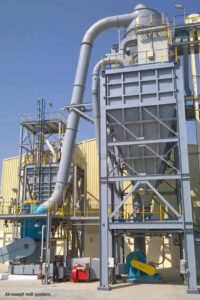Part 1 of a 5-part blog series: “The Importance of Phosphate Milling”
 Bradley Pulverizer’s Ian Hancock, VP of Sales & Operations, discusses the importance of a holistic understanding of the phosphate milling process to ensure maximum plant uptime, the highest process efficiencies and profitability. Click Here to download the complete article in pdf format as published by BCInsight Ltd in Fertilizer International July|August 2021, issue 503, pp. 49-52.
Bradley Pulverizer’s Ian Hancock, VP of Sales & Operations, discusses the importance of a holistic understanding of the phosphate milling process to ensure maximum plant uptime, the highest process efficiencies and profitability. Click Here to download the complete article in pdf format as published by BCInsight Ltd in Fertilizer International July|August 2021, issue 503, pp. 49-52.
 Grinding and pulverizing mills are the furthest upstream process in phosphate fertilizer manufacturing. The continuous crushing of phosphate rock to meet particle size specifications is essential for efficient downstream processing. Yet mills are more commonly seen as the ‘noisy neighbor’ to other process steps, rather than the essential engine that drives phosphates production. Regrettably, this lack of recognition for the importance of milling can cause inefficiencies upstream that are further compounded downstream.
Grinding and pulverizing mills are the furthest upstream process in phosphate fertilizer manufacturing. The continuous crushing of phosphate rock to meet particle size specifications is essential for efficient downstream processing. Yet mills are more commonly seen as the ‘noisy neighbor’ to other process steps, rather than the essential engine that drives phosphates production. Regrettably, this lack of recognition for the importance of milling can cause inefficiencies upstream that are further compounded downstream.
Phosphate rock is fed into the front-end of a production plant and manipulated many times during its long process journey and eventual transformation into valuable end-products. This continual production process is central to efficient phosphate fertilizer manufacturing, with each process stage requiring specialized equipment.
The production process starts with crushing and grinding phosphate in a mill. This then feeds downstream processes such as acidulation, mixing, and pelletizing through to final packaging. Every item of process equipment is interdependent, with the whole plant functioning as an interconnected network. In many ways, it is the upstream milling of phosphate rock that ultimately drives plant profitability and the overall quality and yield of the end-product.
It therefore follows that a holistic approach to fertilizer production is critical. That is because the continuous nature of the plant production process means adjustments to one piece of machinery will almost always require adjustments to other equipment, both upstream and downstream.
Unfortunately, however, this holistic approach is not always followed. The result is lower quality products, lower yields, and higher maintenance costs. In our view, this often occurs because fertilizer processing incorporates very different process steps – each one being covered by a separate engineering discipline. The upstream crushing and grinding of phosphate rock, for example, requires a comprehensive understanding of mechanical engineering and material properties, while downstream phosphoric acid production requires chemical engineering expertise. Metallurgists also make a vital contribution to phosphate beneficiation.
Expecting plant operators to employ large numbers of engineering graduates able to cover every single process step is not always going to be economically feasible. Nevertheless, staffing imbalances, in which one engineering discipline is overrepresented, can inevitably lead to an overemphasis on one process while others are overlooked.
To ensure a holistic approach, we would therefore encourage fertilizer manufacturers to view their processing plant as a series of specialized yet equally important circuits that work together as one whole system. To be managed properly, each circuit within the overall system should be staffed appropriately in our view.
When partnering with our clients, we focus on the importance of the upstream milling system in a phosphate fertilizer production plant – explaining how a proper understanding of its role can enhance overall processing efficiency, yield and plant profitability.
Contact Us to discuss your phosphate or fertilizer milling requirements.
(US) 855-670-8777 | (International) +44 1322-559-106
